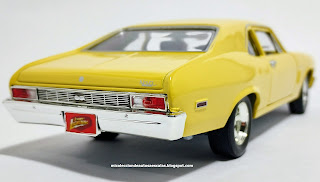El Chevrolet Chevy II / Nova es un automóvil que fue producido en los Estados Unidos, desde 1962-1979 por Chevrolet (división de General Motors) y desde 1985-1988 por NUMMI, un joint venture entre General Motors y Toyota.
En su formato original, el Chevy II fue un modelo en la gama compacta superior, hasta que el nombre Chevy II ha sido cambiado para el modelo de 1969 por el de Chevrolet Nova.
Su primera generación estaba disponible en cinco estilos de carrocería: sedán de 4 y 2 puertas, cupé de 2 puertas sin parantes, familiar y descapotable, mientras que la tercera generación estuvo disponible en carrocería de Fastback, un sedán de 4 puertas y un cupé de 2 puertas.
En su formato posterior, fue un automóvil subcompacto de tracción delantera basado en el Toyota Sprinter japonés.
Después de que el Chevrolet Corvair, de motor trasero, fuera prácticamente desbancado por el Ford Falcon convencional en 1960, Chevrolet comenzó a trabajar en un coche compacto más convencional que terminaría finalmente siendo el Chevy II. El automóvil fue de construcción semi-monocasco con un chasis frontal unida a la cabina monocasco y la sección trasera del baúl, y estuvo disponible en versiones sedán de 4 y 2 puertas, cupé de 2 puertas sin parantes, así como también en versiones descapotable y familiar. El Chevy II de 1962 se produjo en tres series: la Serie 100, Serie 300 y Serie Nova 400.
Un motor de 153 plgs3 (2.51 L) de 4 cilindros, que desarrollaba 90 HP (67 kilovatios) era el estándar; y un motor de seis cilindros en línea de 194 plgs 3 (3.18 L) con 120 HP (89 kilovatios), estuvo disponible. El 6 cilindros fue la tercera generación del motor, definitivamente reemplazando el Stovebolt de segunda generación. Su rival Chrysler desarrolló antes el "Slant 6" en su modelo Plymouth Valiant, como enemigo del Chevy II, cuando los fueron introducidos al público a finales de 1959 como modelos de 1960.
Aunque el Nova no estaría disponible originalmente con una opción V8, el alojamiento de su motor estuvo proporcionado perfectamente para un motor así. No pasó mucho tiempo para que los motores V8 Chevrolet fuesen ofrecidos como opciones instaladas por un distribuidor autorizado (entre 1962 y 1963), incluso agregando la versión con inyección de combustible, disponible en el Corvette. La combinación de motores V8 y el peso ligero fácilmente disponibles, hicieron al Nova una elección popular entre los corredores de piques.
En 1962~63, el Nova estuvo disponible en versión descapotable; y entre 1962~65 en versión de dos puertas sin parantes, aunque el «hardtop» fue presentado cuando los modelos de 1964 fueron introducidos antes y traído posteriormente a la serie, más adelante. Como todos los modelos de Chevrolet de dos puertas sin parantes, este estilo de carrocería fue comercializado como Sport Cupé.
La opción Super Sport (RPO-Z03) que estuvo disponible por primera vez en el Chevy II Nova Serie 400 en 1963, ofreció emblemas especiales, paquete de instrumentos, tapacubos, molduras laterales, asientos de butaca y caja de cambios manual de cuatro velocidades con palanca al piso; y solo estuvo disponible en el cupé de la Serie 400 el deporte y convertible. Como se mencionó anteriormente, el Nova no llevó oficialmente motores V8 hasta este entonces, ya que el motor estándar del SS fue un motor de 6 cilindros, pero era muy común entre los fanáticos cambiar esos 6 cilindros por motores V8 de bloque pequeño. En 1964, fue presentado el primer Chevy II con un motor V8 opcional, el cual fue uno de 283 plgs3 (4.64 L) y 195 HP (145 kilovatios). En 1965, un V8 de 327 plgs3 (5.36 L) también estaba disponible con una potencia de 300 HP (224 kilovatios).















































